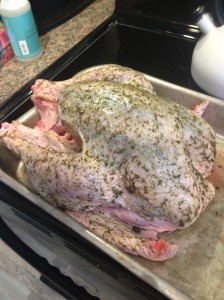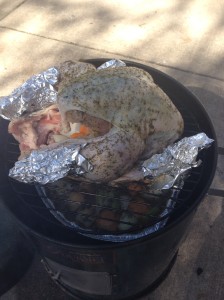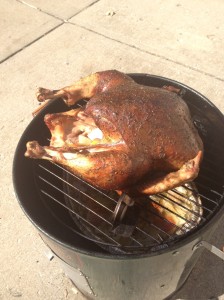Applewood Smoked Turkey
This procedure was my experimental test run for Thanksgiving. I used a twelve pound fresh turkey. If you use a frozen turkey, follow the recommended instructions for properly thawing the turkey before using it. That is step #1 in avoiding Salmonella poisoning. My turkey was also pre-brined. If you buy a turkey that isn’t already prepared like this and you want to brine it, it isn’t too hard to find out how by conducting a simple Google search.
I use a Brinkman charcoal grill/smoker. This recipe can also be made using a normal charcoal/gas grill. The key is to just be able to cook the turkey over indirect heat at a temperature of as close to 325 F that you can get. It’s up to you to figure out how best to achieve this with your particular setup. You will need a good grill thermometer (placed at the grate level where the turkey is sitting. If you have a thermometer already built into the lid of the grill, ignore it) and a food thermometer. The only way you can be sure if the turkey is properly cooked is by checking the meat temperature itself. However long that takes will vary from turkey to turkey, from grill setup to grill setup, and a whole host of other factors.
Preparing the turkey
If your turkey has one of those plastic, popup thermometers yank it out. Remove the plastic contraption binding the legs together. Remove the neck and the bag of other innards from the inside of the turkey cavity. Save everything but the liver. They will go into the gravy. Cut the wingtips off at the first joint and save them for the gravy. Cut off the “pope’s nose”. This is the large, fleshy protuberance at the bottom of the cavity that was binded up in that plastic contraption with the legs. Trim off any excess fat that is around either opening of the cavity.
Preparing the wet rub for the turkey:
Simon and Garfunkel’s Spice Blend ingredients:
1 Tbsp. dried crushed parsley
2 Tbsp. dried crushed sage
1 Tbsp. dried crushed rosemary
1 Tbsp. dried crushed thyme
1 Tbsp. dried crushed oregano
1 Tbsp. dried crushed basil
1 Tbsp. dried crushed bay leaf
1 Tbsp. ground black pepper
1 Tbsp. sugar
Add all the ingredients to a blender and pulse for several minutes to achieve as fine of a powdered mix as possible. Transfer powder to a jar or ziploc bag for storage.
Make a wet rub by combining a tablespoon or two of the spice mix with the same amount of olive oil. If possible let the wet rub sit for a couple of hours to let the oil break down the cells of the herbs to solubilize more of the flavors. We want to liberally apply the wet rub, underneath the skin so it doesn’t have to fight to penetrate through it in order to contact the muscle. I just did this for the breast meat and didn’t bother trying to figure out how to do it for the legs and the thighs. Apply the remaining wet rub all over skin of the entire turkey. This will help to get the skin nice and crispy.
Instead of stuffing the turkey, place a few aromatic ingredients in the cavity. Stuffing the turkey will just block the smoke from entering the cavity, drastically increase your cooking time, and make it difficult to get an accurate reading on the overall doneness of the meat when you check it with a thermometer.
Aromatics:
3 cloves garlic, coarsely chopped
2-3 sprigs of fresh sage
1 onion, ends chopped off but the skin left on, quartered
The peel of one orange
Place these ingredients inside the cavity, making sure there is still plenty of space for heat and smoke to penetrate in. Take four pieces of aluminum foil that are large enough to wrap around the tips of the drumsticks and the wings. Coat the insides with olive oil. Wrap the ends of the drumsticks and wings with the foil. This will prevent them from getting overcooked. The foil will be removed after about an hour so the skin can get as equally brown and crispy as the rest of the bird.
Preparing the gravy
We will place a drip pan below the turkey while it cooks to catch all of the drippings which will then be turned into a gravy.
Gravy ingredients
3 qts water
Turkey neck, gizzards, wingtips that you removed earlier
1 cup apple juice
2 carrots, cut into 2 inch lengths
2 celery stalks, cut into two inch lengths
2 onions, ends chopped off, skin left on, cut into quarters
1 Tbsp, dried sage leaves
1 Tbsp, dried thyme leaves
2 whole dried bay leaves
Place all of the ingredients in a pan that is safe to put in your smoker/grill. I used a 9×13 disposable aluminum foil pan. This pan will sit under the turkey to catch all of the drippings during the smoking process.
Light the charcoals/preheat gas grill to achieve as close a temperature to 325 F as possible on the cooking grate where the turkey will be sitting. When the grate is hot, scrape off any residue that is already on it to prevent unwanted flavors from dripping into the gravy pan. Place gravy pan below the grate that will hold the turkey. Place a couple of handfuls of applewood chips in a pouch made of aluminum foil. Make sure to either poke holes in it, or leave the ends open so the smoke can escape. Place the pouch directly on the coals/heat source.
Place the turkey on the grate and close the smoker/grill lid. Try not to disturb it for an hour, but you still want to monitor the grill temperature. My turkey was 12 pounds and took about 2.5 hours to cook. You are aiming for a meat thermometer reading of 160 F deep in the breast meat. After an hour of smoking, remove the foil from the drumsticks and wings. During the smoke, you will probably need to keep adding coals and wood chips as necessary to keep your cooking temp high enough and replenish the smoke supply.
When the meat temp is close to 160F, dump the aromatics in the turkey cavity into the gravy pan. When the turkey is done, remove from the smoker and let it rest for at least 15 minutes prior to carving it. Pour the contents of the gravy pan through a strainer into a large sauce pan and let it stand. You can either use the thin gravy as is, or you can thicken it to make a more traditional style gravy.
Thick gravy
4 Tbsp butter
4 Tbsp flour
1 cup liquid from the gravy pan
Melt the butter on medium heat in a saucepan. Whisk in the flour and keep stirring, keeping the mixture smooth. Keep doing this for a couple of minutes. Slowly pour in the liquid from the gravy pan, while continuing to stir. Remove from the heat and stir a couple more minutes.


You must be logged in to post a comment.